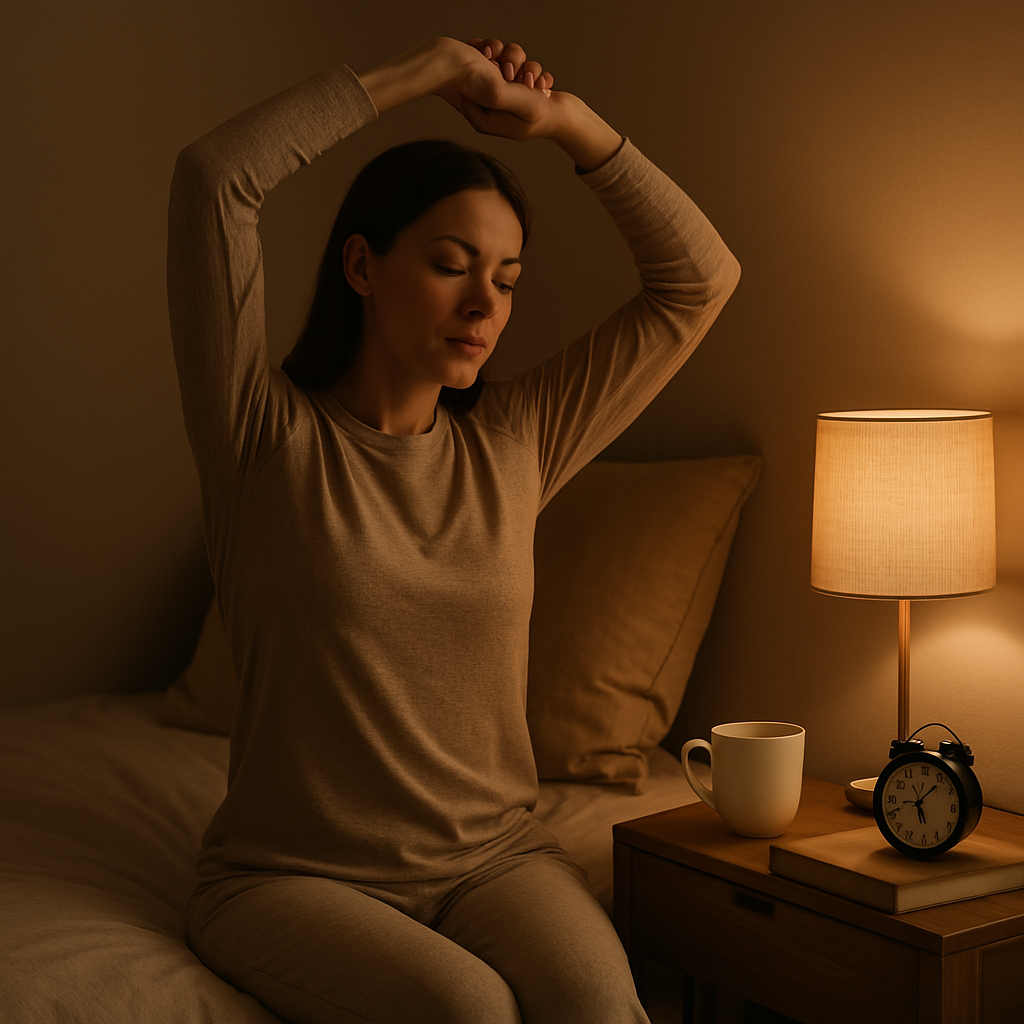You don’t just sleep in your bedroom — you sleep because of it.
Your Bedroom Sets the Tone for Your Sleep
You’ve done the wind-down routine. You’ve adjusted your schedule. You’re even waking up earlier.
The missing piece might be right in front of you: your bedroom.
But… you’re still waking up at 3AM. Still tossing. Still wired when you should be winding down.
From lighting to layout, temperature to clutter, your environment sends constant signals to your brain — and it may be saying “stay alert” instead of “it’s safe to sleep.”
Here’s how to transform your bedroom from functional to deeply restorative — without a full redesign.
Why Your Sleep Environment Matters More Than You Think
Sleep isn’t just biological — it’s sensory.
Your brain is wired to scan for safety, comfort, and cues of “day vs night.”
That means your bedroom isn’t just where you sleep — it tells your body how to sleep.
But if your room is bright, cluttered, noisy, or inconsistent, your body may not get the message.
Signs Your Bedroom Might Be Sabotaging Your Sleep
- You wake up often, even if you’re exhausted
- You feel alert when you walk into the room at night
- You scroll in bed and struggle to “switch off”
- You feel too hot, too cold, or uncomfortable
- You associate your room with stress, not rest
Small details — a glowing charger, noisy fan, cluttered nightstand — can create a sense of mental and sensory alertness that keeps you out of deep sleep.
How to Make Your Bedroom More Sleep-Friendly
Let’s turn your bedroom into a space that invites rest and cues relaxation.
🌑 1. Make It Dark (Really Dark)
Light is the biggest signal your brain uses to determine if it should be awake.
Even low-level light can delay melatonin and keep your sleep shallow.
Try this:
- Use blackout curtains or blinds
- Remove or cover LEDs from chargers, clocks, or power strips
- Put on your sleep mask before you’re in bed, to cue your body to wind down
🎯 Our 3D Sleep Eye Mask blocks out all light, without pressing on your eyes — ideal for full blackout and maximum comfort.
🔇 2. Make It Quiet (or Consistently Noisy)
Inconsistent noise is worse than constant sound. Your brain reacts to change — footsteps, creaks, birdsong — even if you’re asleep.
Try this:
- Use white noise or soft ambient sound
- Add rugs, curtains, or soft furnishings to absorb echoes
- Wear earplugs if needed — especially if you live in a noisy area or sleep lightly
🎯 Our Noise-Cancelling Earplugs are soft, reusable, and designed to block subtle background sounds without discomfort.
❄️ 3. Set the Right Temperature
Your core body temperature drops to initiate deep sleep. If your room is too warm, you’ll toss and turn all night.
Try this:
- Keep your room between 16–19°C (60–67°F)
- Use breathable bedding and lightweight sleepwear
- Layer blankets so you can adjust during the night
Cool, quiet, dark — the trifecta of better sleep.
🧘 4. Remove Visual Clutter
Your brain processes your environment, even when you’re not thinking about it.
A cluttered space = a cluttered mind.
Try this:
- Clear your nightstand (one book, one lamp, maybe a candle)
- Put away clothes, chargers, and laundry baskets
- Add one calming object — a plant, a photo, a soft light
Think: hotel-level simplicity with your personal sense of calm.
📵 5. Make It a Phone-Free Zone (If You Can)
Your phone is a mental and emotional stimulant — not a calming bedtime companion.
Try this:
- Charge your phone outside the bedroom (or across the room)
- Use a sunrise clock or analog alarm instead
- Replace evening scrolling with reading, stretching, or journaling
You’ll fall asleep faster and wake up less reactive.
Bonus Tips for Bedroom Transformation
- Use calming scents (lavender, sandalwood, or chamomile)
- Keep colours soft and neutral
- Keep electronics minimal or covered
- Invest in quality bedding that you actually look forward to using
- Use your mask + earplugs at the same time every night to build a wind-down ritual
🎯 Our Fall Asleep Faster Kit combines all the essentials — 3D Sleep Mask + Noise-Cancelling Earplugs — so you can create the perfect sensory shutdown every night.
Build a Bedroom That Works For Your Sleep
You can’t force sleep — but you can invite it.
And the space you sleep in plays a bigger role than you think.
When your bedroom feels calm, consistent, and safe, your nervous system naturally lets go. Your sleep deepens. Your mornings feel better.
Start with one small change tonight — maybe it’s dimming the lights earlier. Maybe it’s using your mask + earplugs as your cue to wind down.
Over time, your bedroom won’t just be where you sleep — it’ll be why you sleep better.
💬 Frequently Asked Questions (FAQs)
Can my bedroom really affect how well I sleep?
Yes — your brain processes sensory input from your environment even while you’re asleep. Light, noise, temperature, and clutter can all disrupt sleep quality.
What’s the best temperature for sleep?
Most people sleep best between 16–19°C (60–67°F). If you’re waking up sweaty or cold, temperature might be the issue.
Are sleep masks and earplugs safe to use every night?
Absolutely. Just choose high-quality, breathable materials and clean them regularly. They’re ideal for creating a consistent sensory shutdown routine.
What can I do if I can’t block out all the noise/light in my bedroom?
Use personal tools like a sleep mask and earplugs — they give you control, even in shared or imperfect spaces.
How quickly will changes to my bedroom improve sleep?
Many people notice a difference within 1–3 nights, especially with changes to light and noise exposure.



Leave a comment
This site is protected by hCaptcha and the hCaptcha Privacy Policy and Terms of Service apply.